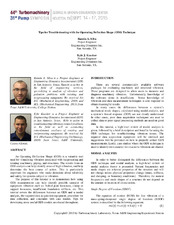| dc.contributor.other | Turbomachinery Symposium (44th : 2015) | |
| dc.creator | Silva, Ramon A. | |
| dc.creator | Kuecker, Kyle J. | |
| dc.date.accessioned | 2017-09-09T14:06:13Z | |
| dc.date.available | 2017-09-09T14:06:13Z | |
| dc.date.issued | 2015 | |
| dc.identifier.uri | https://hdl.handle.net/1969.1/162134 | |
| dc.description | Tutorial | en |
| dc.description.abstract | An Operating Deflection Shape (ODS) is a valuable tool used for visualizing vibration associated with reciprocating and rotating machinery, piping, and structures. The results from an ODS analysis can help identify areas of high vibration, and help determine the best course of action. This is particularly important for engineers who make decisions about reliability and safety for systems subject to vibration. The purpose of this tutorial is to demonstrate how using ODS measurements can help identify possible cause(s) of equipment vibration such as: bolted joint looseness, clamp or support looseness, insufficient foundation stiffness, etc. This tutorial covers the differences between an ODS and a modal analysis, the required data acquisition equipment, procedure for data collection, and concludes with case studies. Tips for developing more useful ODS models are shared throughout. | en |
| dc.format.medium | Electronic | en |
| dc.format.mimetype | application/pdf | |
| dc.language.iso | en | |
| dc.publisher | Turbomachinery Laboratories, Texas A&M Engineering Experiment Station | |
| dc.relation.ispartof | Proceedings of the 44th Turbomachinery Symposium | en |
| dc.subject.lcsh | Turbomachines | en |
| dc.title | Tips for Troubleshooting with the Operating Deflection Shape (ODS) Technique | en |
| dc.type.genre | Presentation | en |
| dc.type.material | Text | en |
| dc.format.digitalOrigin | born digital | en |
| dc.identifier.doi | https://doi.org/10.21423/R1MD00 | |


